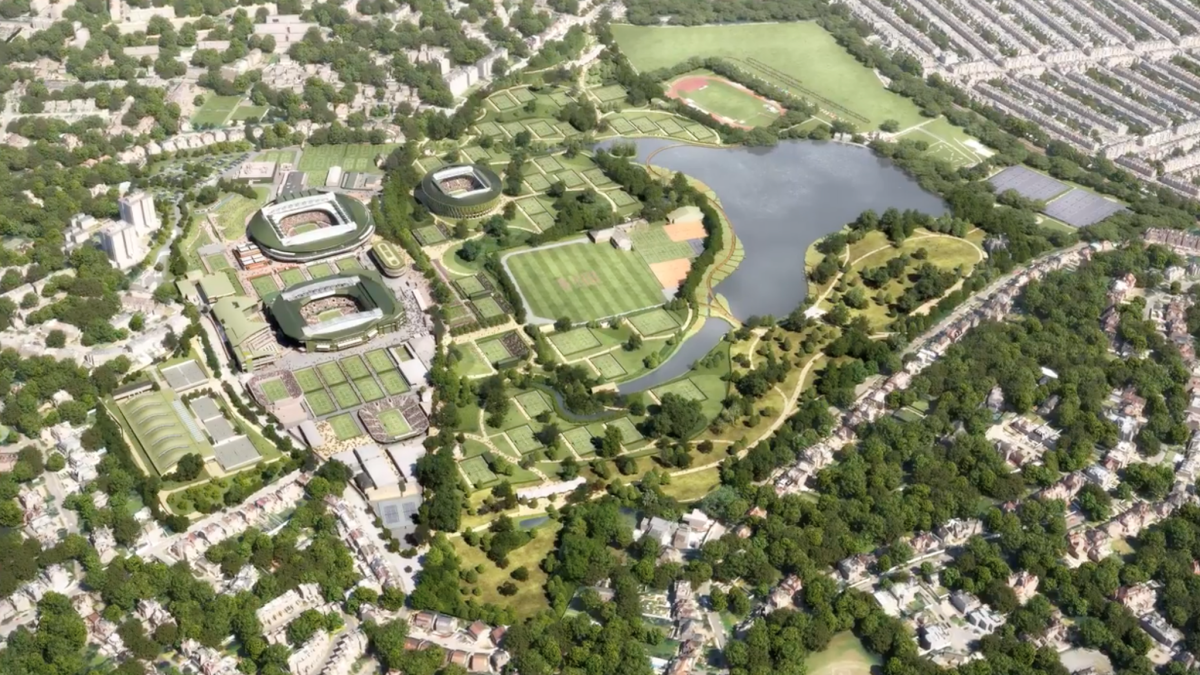The A Wimbledon Championships is making significant progress towards its goal of featuring a new 8,000-seater stadium with a retractable roof and on-site qualifying. The Merton Council’s planning committee has granted permission for the construction of 39 new courts on the former site of Wimbledon Park Golf Club, located just across the road from the All England Club (AELTC). The decision was made with a six to four majority in favor of the scheme.
However, despite this positive outcome, the AELTC still faces opposition from local residents. One spectator even shouted that the council chamber had become a “climate crime scene,” bringing the meeting to an abrupt end. If the plans move forward, the new courts are not expected to be operational until at least 2030.
The proposed development was met with concerns from planning officers about potential harm to Metropolitan Open Land. However, they concluded that “very special circumstances” outweighed the harm due to the substantial public benefits it would provide. Outside the council chamber, approximately 75 members of the Save Wimbledon Park organization voiced their concerns, holding signs that read “It’s just not tennis” and “Stop corporate ecocide.”
Prior to the vote, one council member criticized the plans for being “too big” and potentially harmful, while another questioned the benefits for anyone other than the All England Club. However, there were also those who praised the application for its economic advantages, referring to it as a “game-changing” proposal.
The All England Club’s plan includes the construction of 39 new grass courts, including an 8,000-seater show court, on the former Wimbledon Park Golf Club site. Currently, the Wimbledon qualifying matches are held at the Bank of England Sports Centre in Roehampton, roughly three-and-a-half miles away from the All England Club. With the new courts, qualifying matches will take place on-site, aligning Wimbledon with the other three Grand Slam tournaments. The additional capacity will allow up to 10,000 spectators to watch qualifying matches and up to 50,000 spectators to enter the grounds during the main tournament.
The new show court will boast 8,000 seats, a retractable roof, and climbing plants on the walls. It will provide another large show court, allowing matches to be played regardless of the weather. With the expansion of the facilities, players will no longer need to share practice courts, and the All England Club has committed to doubling the size of the wheelchair draw tournament.
In addition to the improvements for players and spectators, the development plans include the creation of a new 23-acre public park. Modeled after the original design by Lancelot “Capability” Brown, the park will be accessible to the public throughout the year, excluding the weeks of the Championships. The project also involves clearing silt from the lake, installing a new boardwalk, and making at least seven grass courts available to the local community during the summer weeks following Wimbledon. According to Merton Council’s report, the plans will contribute to people’s health and well-being, boost the local economy, and create more employment opportunities in the area.
Despite the positive aspects highlighted in the development plans, strong opposition from local residents remains. Wimbledon MP Stephen Hammond and Putney MP Fleur Anderson have expressed their joint opposition to the project, with concerns raised by organizations such as the Wimbledon Society and the Capability Brown Society. A petition initiated by Save Wimbledon Park, which aims to address environmental impact and the loss of trees and open spaces, has garnered over 13,000 signatures. During the AELTC’s consultation process, local residents voiced their grievances, referring to the organization as an “insular and imperial group of expansionists.”
Concerns regarding the new show court’s impact on the view, increased traffic, noise, and environmental consequences during the construction phase have also been raised. While some worry about the removal of 296 trees, the AELTC plans to plant 1,500 new trees, with most of those being felled in poor condition and having a short life expectancy. Others express apprehension about the larger number of spectators that will be able to access the site daily, while some believe that the AELTC intends to use the site for a hotel complex. Furthermore, many residents are still displeased with the yearly closure of Church Road during the Championships.
While the AELTC has made progress, there are still potential obstacles to overcome. The scheme requires approval from the planning committee in the borough of Wandsworth, as the northern part of Wimbledon Park falls within their jurisdiction. The Mayor of London will then need to formally accept or reject the decisions made by both councils in relation to the development on Metropolitan Open Land. Legal challenges, including judicial review, may also pose a threat to the AELTC’s plans. However, success in such cases is rare.
Before any development work can begin, a 30-year-old legal covenant related to the golf course’s transfer from Merton Council to the AELTC in 1993 must be resolved. The covenant restricts the use of the land for leisure, recreational, or open purposes. Resolving all these challenges will be necessary for the All England Club to proceed with its plans and ensure that Wimbledon remains at the pinnacle of the sport.

Jessica Roberts serves up the latest in the world of tennis. With a love for the racket sport, she reports on tennis matches, player rankings, and Grand Slam events, ensuring readers stay informed about the tennis world.




:no_upscale()/cdn.vox-cdn.com/uploads/chorus_image/image/72931262/usa_today_21973134.0.jpg)


